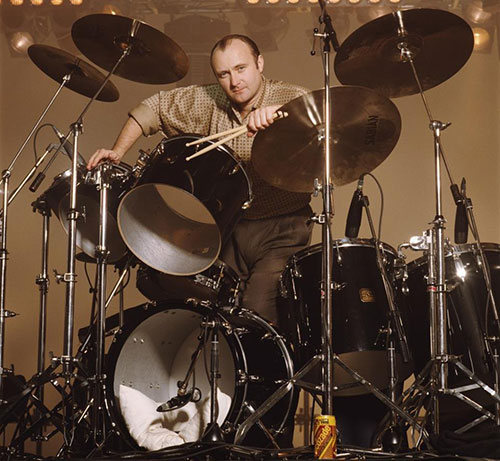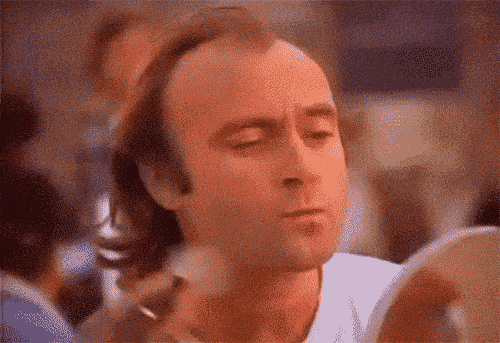Take a look at me. Now.
Phil Collins doesn't deserve the scathing criticism he receives—he's one of the most creative minds in rock history, and he's an amazing drummer. Really.

Phil Collins is an awesome drummer who doesn’t require a jacket
In a lot of ways, Phil Collins fell into pop stardom kind of by accident. Starting his career as an actor, he played in a couple of small-time bands before getting a chance to audition with Genesis in 1970—an audition he easily pulled off despite taking a swim almost immediately beforehand.
Now, before we go any further, I have to explain something here: The early-1970s version of Genesis was not the band that played “Invisible Touch,” or as I liked to think of that song when I was seven years old, “Invisible Top Shelf.” Genesis was a bold, ambitious band at a time when King Crimson was considered a peer. And Collins’ early years in the band helped burnish his reputation as a hugely talented technical drummer—and a steadying presence for Genesis.
“Phil felt like a professional who played with other musicians, and was just getting on with the work, whereas we had all these intense dysfunctional family arguments going on,” Peter Gabriel, the band’s first singer, said of Collins’ early work.
Perhaps the album his drumming capabilities are most closely tied to is The Lamb Lies Down on Broadway, a 1975 concept album that was considered one of the most overly complex rock albums ever created—one so complex that people have gone out of their way to annotate the cryptic lyrics on the record.
But the album, and its infamously over-the-top tour, which Collins suggested was “what ‘Spinal Tap’ was written for,” further strained the band and led to Peter Gabriel’s departure.
The band looked everywhere for a new vocalist, trying out hundreds of different singers. Eventually, Collins tried out a song, and the result was stellar.
The problem, of course, is that Collins was the band’s drummer, and he was simply too good at drumming to give up that role. While there are other full-time drummers who built simultaneous reputations as singers—most notably fellow ‘80s schmaltz-popper Don Henley—we’re talking about a band that was known for crazy-ass time signatures at the time.
Collins, however, could pull it off, though he did have a bit of help. At first, King Crimson drummer Bill Bruford took on the gig for a while. Eventually, though, the band brought on Frank Zappa’s former thumper, Chester Thompson, who became Collins’ backup live drummer, holding onto that role for more than three decades and assisting with Genesis and Collins’ solo career.
This collection of drum power meant that Genesis shows in the ‘70s and ‘80s were real treats. Check out this drum solo and tell me Phil Collins isn’t awesome. You just can’t.
“A drummer contacted me and said, ‘I love [John] Bonham so much I wanna sit behind you when you sing. It was Phil Collins. His career was just kicking in and he was the most spirited and positive and really encouraging force, because you can’t imagine what it was like, me trying to carve my own way after all that.”
— Robert Plant, discussing how Phil Collins reached out to him in the days after John Bonham died, a tragedy that effectively ended Led Zeppelin in 1980. Collins, who was just months away from launching a solo career of his own, nearly gave up the opportunity to do so because he wanted to support a grieving Robert Plant. Just like Collins did in 1986 for No Jacket Required, Plant would go on to win the Grammy for Album of the Year for his 2009 collaboration with Alison Krauss, Raising Sand.

Phil Collins helped invent a drum sound that was the ‘80s version of autotune
When it comes to “In the Air Tonight,” there’s one part that everyone remembers. It’s a set of thumping beats that comes in about two thirds of the way through the song.
Prior to that moment, the drums are just a patter through the song, a sound that gives the song a very unique feel unlike anything else in the era. (A few years later, this wouldn’t be the case, as it soon become widely imitated by numerous artists.)
The sound is a studio effect called “gated reverb,” an aired-out snare drum sound that sounds like it came from a synthesizer. It didn’t. The drum beat was actually made by a real snare drum, probably hit by Collins, with a handful of electronic effects to make it sound unlike any natural drum could make.
These days, you can easily recreate it using some electronic effects, but when Collins and his producer, Hugh Padgham, first came onto the idea, it involved a room that was very well-attuned to drum beats, some well-placed microphones, and an electronic device called a noise gate.
The room gave the drums a very reverb-y sound, so that the effect was similar to what you might hear at a live show. But in recording, the beat of the drum was compressed a bit, which might be akin to hearing a live drum from the bathroom at the stadium. But the real secret to making this work is the noise gate, which takes this airy sound and cuts it off.
In a way, they effectively made a drum sound that has the patter of pressing a key on a keyboard despite having a “big” sound.
“[W]hen you go from something sounding big to nothing, i.e. a sort of anechoic chamber, you get this feeling of massive contrast,” Padgham explained in an interview. “That is the whole essence of why the sound was so interesting because it is going from all to nothing in milliseconds.”
Collins and Padgham didn’t introduce the sound on “In the Air Tonight”; Peter Gabriel’s “Intruder”, a track Collins drummed on, gets credit for being patient zero. (Padgham and Collins discovered the sound while working on Gabriel’s solo album.)
But as a result of a tight relationship with a clever producer, Collins’ sound can be heard all over pop music from the ‘80s. Again, why the hate?
416
Perhaps the one musician who got less respect than Phil Collins during the 1980s is Philip Bailey. Bailey, one of the lead singers of Earth, Wind & Fire, had a massive solo hit in 1984.
The problem was, the one thing people remember about the hit is the fact that Phil Collins sings the hook. Collins was in the studio producing the song that became “Easy Lover” when a suggestion from another co-writer on the track, studio musician Nathan East, led to a situation where Collins accidentally took over:
The other thing that I noticed was that when Phil Collins was singing along with Phil Bailey, it was a Phil Bailey record, but I was vibing with his voice and how great it sounded with Phil’s, and I said, “You have to sing on it, too, Phil, this could be a duet,” and so Phil took it home and the next day he came in with these lyrics, “Easy Lover,” and it was like, “Get in there and sing the song, guys.” They went in there and that was it.
Despite the fact that the song was originally intended as a Philip Bailey solo track, it became a duet. These days, such a situation is common in pop music, but there was little precedent for it in 1984.
The music video attempted to play up the idea that the two artists worked on the song together, but when people hear it on the radio, they assume it was off of one of Collins’ solo albums—a situation reinforced by the fact that Collins put the track on his greatest-hits album with no reference to Bailey.
Personally, I like to imagine that Genesis’ “Land of Confusion” was written about the recording process around “Easy Lover.”
:format(jpeg)/2018/04/ro3f2bw5wslt8ozm3epu.gif)
/2018/04/ro3f2bw5wslt8ozm3epu.gif)

/uploads/ernie_crop.jpg)